Fife Council leader David Ross intends to write to Finance Secretary John Swinney to warn him the Scottish and UK Governments may have underestimated the impact of the so-called bedroom tax on Fife.
Mr Ross said Fife Council had already received and spent crisis grants from the Scottish Welfare Fund.
But he warned Fife was one of two councils in Scotland that had used discretionary housing payments from government. This was representative of the demand for support in Fife and the work of council officers.
He warned that while welcome, the hardship payments were not retrospective and already more people were getting into rent arrears.
He said it was inevitable the council would have further pressures to deal with.
“I’ll be writing to John Swinney to say that if we get our share based on our population, then that underestimates the impact of the ‘bedroom tax’ on Fife tenants. We will be arguing for a greater share.”
The issue arose at Tuesday’s Fife Council executive committee in Glenrothes as councillors reviewed the use of the welfare reform budget and considered future arrangements.
The council has acknowledged welfare reform continues to place pressure on council resources as changes are made to the benefit system.
The council’s budget strategy recognises this and £5.435 million has been added to the revenue budget to allow the council to respond to the service budget pressures arising from welfare reform and provide support to those most adversely affected.
SNP Dunfermline councillor Neale Hanvey said the report did not go into the broad human impact of the Westminster Government’s “pernicious” policy.
Conservative St Andrews councillor Dorothea Morrison said she struggled to get her head round why the impact of this recession seemed to have a greater impact on individuals now than during past recessions.
“My grandmother was poor and she never used a foodbank,”she said.
She urged the council to remember that perceived affluent areas such as her own St Andrews ward also had people who were “struggling” and it was important they also received support.
SNP group leader Peter Grant said it was simple people used foodbanks because they couldn’t afford to eat. There were many working people on low wages who still had to use foodbanks.
Lochgelly Labour councillor Mark Hood raised concerns about the potential impact on health services if people were not able to feed themselves properly.
Independent Buckhaven councillor Andrew Rodger said: “I have been stopped in the street by genuine people in their fifties and sixties.
“They say: ‘If we get a mild winter I’ll pay my council tax. If we get a bad winter I’ll pay my fuel bill’. They never mention food.”
Deputy council leader Lesley Laird said getting people into work was a key to breaking the “cycle of poverty”.
